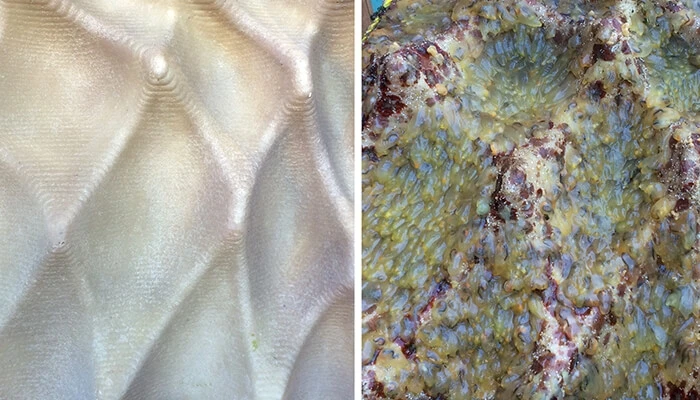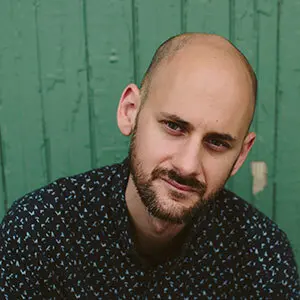& Construction

Integrated BIM tools, including Revit, AutoCAD, and Civil 3D
& Manufacturing

Professional CAD/CAM tools built on Inventor and AutoCAD
From a distance, you could be forgiven for thinking the Buoyant Ecologies Float Lab installation is merely a boat.
The vessel is actually a product of the California College of the Arts (CCA) Architectural Ecologies Lab. It’s seaworthy, with a fiberglass hull and oblong shape, but meant for a decidedly nonboating purpose: Rather than slicing through the water, the floating installation is designed to stay put, slowly accumulating marine flora and fauna (a process called “fouling”) from the local habitat. The Float Lab will be anchored in San Francisco Bay at Oakland’s Middle Harbor Shoreline Park in August 2019; it will hang out a few hundred feet offshore for a three-year tour to nowhere.
A team of architects and designers at CCA crafted the lab to glean information for marine biologists and ecologists about underwater ecosystems. The primary question is whether the semipermanent structure can attract a diverse marine community, relieving some of the pressure that flora and fauna experience from invasive species and climate change. (The lab builds upon research in the San Francisco Bay, but its premise is scalable to other locations.)
This prototype is the latest (and largest) in a series of two dozen that CCA has worked on since 2014. It’s the size of a small car (15 feet by 9 feet) and vaguely heart-shaped, which could facilitate multiple installations to link together in a tessellated pattern.
Much of the team’s research has run counter to the way marine experts usually study the collection of living matter on seafaring vessels. There’s plenty of data on how to prevent this accumulation, which can bog down ships and other boats with added weight and drag, but less information on how to induce and guide that accumulation. The idea behind the Float Lab was to “create diversity through geometry so that the small creatures can exist safely in small pockets without predators getting to them, to create a more robust food chain,” says Adam Marcus, an associate professor at CCA’s architecture school who directs the Architectural Ecologies Lab and the Buoyant Ecologies project with Evan Jones and Margaret Ikeda.
As such, the installation will feature a wide range of topography that encourages nooks, crannies, and niches, prompting a diverse and resilient community to form. Two large mounds make up the centerpiece of the vessel’s shape and a dense series of smaller ridges wrinkle its surface. On an even smaller scale, a rough, granular surface texture offers near-microscopic tentacle (or root) holds.
Throughout design and fabrication, Marcus and his team paid close attention to the installation’s rugosity—the amount of textural variation of its surface, or “the statistics of bumpiness,” as Marcus puts it. “At the end of the day, it’s all about surface area. The more we can increase surface area, at all scales, the more attractive it is for animals.”
The installation won’t be planted or seeded with any species; it’s an open invitation. “We don’t know what to expect,” says Kamille Hammerstrom of the Benthic Lab at Moss Landing Marine Laboratories, one of CCA’s research partners. A key question is whether the structure’s topographic modulation will directly translate into modulating marine-life habitats. Might some critters thrive in the shadow of 1-inch ridges but not be able to abide a 3-inch ridge?
Below the waterline, Hammerstrom anticipates attracting mussels, marine worms, crustaceans, and gastropods such as snails, along with algae and other species that can create additional habitat complexity for other organisms to live in and on. Her team members will scuba-dive out to monitor the installation monthly, identifying and counting plants and animals.
San Francisco Bay suffers from more invasive species pollution than any other coastal estuary in the world; Hammerstrom will keep a special lookout for the Olympia oyster, native to the Northern Pacific, which has been pushed out by invasive species. “We’ve lost a lot of the population of our native oysters,” she says. “But they settle on hard substrates, and we’re hoping that we’ll be able to attract them.” The CCA team is testing chain-like hanging substrate structures that will dangle from the installation and may be particularly attractive to oysters. Marcus calls them “underwater colonnades” and hopes they’ll also mitigate wave action.
Although the primary focus of the Float Lab is generating marine habitats, researchers are curious to learn if a network of such installations could significantly reduce coastal erosion caused by wave action that has been amplified by sea-level rise. The bay’s marshes, wetlands, and mudflats are rapidly being battered and swallowed by the sea; in response, CCA is using computational models to examine the Float Lab and its hanging substrates’ ability to halt this erasure.
Above the waterline, Marcus and Hammerstrom hope the Float Lab can maintain stable tidal-pool habitats. The entire installation is optimized for underwater life, but up top, there’s a chance it could be a restful waypoint for sea birds. Permanent plant and animal life will need all the resources they can get; seagull droppings are one place to start. “That’s going to be an influx of nitrogen, so that could help boost the production of algae,” Hammerstrom says.
The Float Lab’s fabrication process is a hybrid of digital craft and analog construction. Using material economy, the team deliberately limited options to customize a topside shell optimized for tidal-pool and terrestrial life. The installation is made from fiber-reinforced polymer (FRP), a fiberglass variant, ideal for marine applications for its durability, lightness, strength, and customizability. To design topography patterns, Marcus and his team manually specified the largest topographical features, then overlaid a pattern inspired by “reaction-diffusion systems” that algorithmically generated the rest of the installation’s contours.
Custom architectural-composites fabricator Kreysler & Associates used a CNC robot to shape a positive form from expanded-polystyrene foam. From there, a reusable FRP shell mold, cast from the positive, was used to make the identical top and bottom sides of the installation; the two parts were sealed together with resin and sandblasted to raise their rugosity score.
The Float Lab features a handful of mechanical components. An irrigation system trickles water into the tidal pools; two bilge pumps keep the inside dry while concrete ballast keeps the installation steady so the water quality and turbidity sensors can do their work. It’s all powered by rechargeable batteries, fed by solar panels up top.
Autodesk played a key role in the Float Lab’s development since its beginning, sponsoring the first CCA studio on the topic in 2014 and hosting the team at the Autodesk Technology Center in San Francisco. As members of the Autodesk Residency Program, the Architectural Ecologies Lab also gained access to the center’s workshop, fabrication facilities, and in-house industry experts.
The CCA team is “interested in this idea of cohabitation between humans and nonhumans,” Marcus says. But it’s more about that relationship across an ecosystem—not as sea-dwelling neighbors. There’s a long history of utopian thought with the sea as a goal for human habitation, which could accelerate in the wake of cataclysmic climate change. The Float Lab takes a step back from this presumption, first pledging to rebalance and responsibly manage these ecosystems from a distance before launching a new colonial enterprise. Maybe it means no one ever gets close to these new hybrid structures without a wetsuit, maybe it means semi-habitable science labs, or maybe it means something more.
Ultimately, though, the project’s goal is the same overarching principle driving the work of the Architectural Ecologies Lab: to develop architectural strategies that are more sensitive to, and productive for, the broader ecosystem—in other words, a better world for humans and nonhumans alike.
Zach Mortice is an architectural journalist based in Chicago.
AECO
AECO
Rendering courtesy AI SpaceFactory and Plomp.
Emerging Tech









